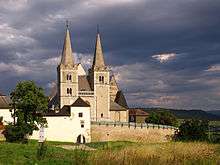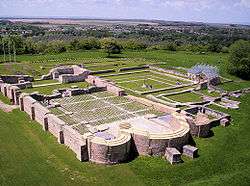Place of authentication

A "place of authentication" (Latin: locus credibilis, Hungarian: hiteleshely) was a legal institution peculiar to the Kingdom of Hungary.[1][2] They were chapters or monasteries obliged to offer services similar the ones now provided by public notaries.[1] For instance, they drew up contracts known as "confessions" (Latin: fassio), issued authentic copies (Latin: transsumptum) of any document kept by or presented to them, and bore witness to the scene of any sort of legal act.[3] Besides their own archives, they also took care of private papers of local noblemen.[4]
The institution came into being at the end of the 12th century, and it stopped functioning in the middle of the 19th century[2] Around 1500 more than thirty ecclesiastic institutions functioned as such in the entire kingdom (out of which two in Transylvania, and also two in Slavonia), but the activities of most of them were restricted to some administrative districts called "counties", only four of them having an authority extending all over the kingdom.[3] They left no room for the institution of public notaries, thus when the latter appeared in the kingdom after 1300, their activity was restricted to the field of canon law.[3]
Origins
Until the late 12th century, only charters issued by the monarchs possessed legal credibility in the Kingdom of Hungary.[2] However, in lawsuits between laymen it had already in the 11th century become customary for oaths to be taken and ordeals to be administered by members of ecclesiastic bodies, such as chapters and monasteries.[1] Around 1200 at the latest chapters started to keep records of the cases that came before them.[3] The earliest example of this practice is the Regestrum Varadinense that contains the minutes of 389 cases brought before the cathedral chapter of Várad (Oradea, Romania) between 1208 and 1235.[3]
.jpg)
Charters issued by chapters and monasteries started to assume an increasingly uniform character of their own from the late 12th century, carrying their issuers' distinct seals.[2] Although charters issued by the royal chancellery or by the kingdom's principal judges (for instance, by the palatine) retained a special authority, documents issued under the name and seal of ecclesiastical institutions rapidly acquired an almost analogous status.[5] Thereafter not only landowners turned to these ecclesiastical institutions to confirm their transactions, but the heads of the counties ("counts") and higher royal officers also sought to have their judgments published under the seal of chapters and monasteries.[2]
Besides preparing documents for fee, these religious institutions began to store them in their sacristy, thus in short time they became authorized to issue authentic copies of any document kept by or presented to them.[3] For instance, around 1400 the archive of the chapterhouse of Esztergom had one charter originally issued by King Béla III (1172–1196), eight published by Andrew II (1205–1235), and twenty-one from the reign of Béla IV (1235–1270), while in 1525 the chapterhouse of Eger was able to produce a copy of a charter issued in 1282.[4][6]
The transformation of the major ecclesiastic institutions into effective agencies of royal administration was associated with the eclipse of the office of pristaldus ("bailiffs"), that was effectively annulled in 1222 by King Andrew II.[7] Thereafter many of the judicial tasks previously performed by the pristaldus (for instance, issue of summons, taking of evidence, and survey of boundaries of estates) was to be assumed by representatives of local chapters and monasteries.[7]
Authority
The process by which a chapter or an abbey acquired a "credible" status depended to a large extent upon contemporary opinion.[2] If an ecclesiastic institution was believed to be scrupulous in its assessment of landowners' rights to property, documents issued under their seals were deemed of an authentic quality.[2] The "credibility" of a charter issued by a chapter or monastery usually only extended to the nearest counties in which its documents and seal were more familiar.[3][5]
Only the ecclesiastic institutions to which the principal judges of the realm commonly turned retained an authority which extended all over the kingdom.[4] These included the house of the Hospitallers at Székesfehérvár, the collegiate chapters of Székesfehérvár, Buda, and (from 1498) the cathedral chapter of Bosnia.[3] Besides them around 1526 fourteen cathedral chapters, seven collegiate chapters, eight Benedictine monasteries and five Premonstratensian monasteries functioned as "places of authentication" with authority within the neighboring one, two or three counties.[3]
Tasks and procedures
Verifying titles of ownership was the most frequent task carried out by "places of authentication".[4] Accordingly, their clerks copied out previously issued charters, checked up on the authenticity of the originals, and recorded the deed either in a register or in the form of a chirograph.[4] The clerks always had to be convinced that a landowner's claims to ownership was genuine before issuing a charter affirming his or her title to landed property.[7] For this purpose, the clerks examined the document, determining by reference both to its writing, seal and other features whether it carried the mark of authenticity in all its details.[7] Private papers of local landowners were kept in deposit boxes sealed by the owners.[4]
First documents from the 14th century attest that "places of authentication" were frequently involved in the conduct of inquisitions; thenceforth plaintiffs most commonly initiated proceedings by registering a claim with the local locus credibilis, asserting either a trespass or assault, or a sale or exchange of land.[8] The matter proceeded through the "place of authentication" to a higher officer of the realm who then required the relevant religious institution to perform an inquisition of the trespass, or introduce the new owner into his property and record any objections made at this time.[8] The representatives of "places of authentication" also attested how estates were divided or their boundaries fixed.[3] In the case of a royal grant, a writ ordered them to witness the investiture of which they were to draw up a record for the grantee.[3]
Footnotes
References
- Engel, Pál (2001). The Realm of St Stephen: A History of Medieval Hungary, 895-1526. I. B. Tauris. ISBN 978-1-85043-977-6.
- Rady, Martyn (2000). Nobility, Land and Service in Medieval Hungary. Palgrave. ISBN 0-333-80085-0.
